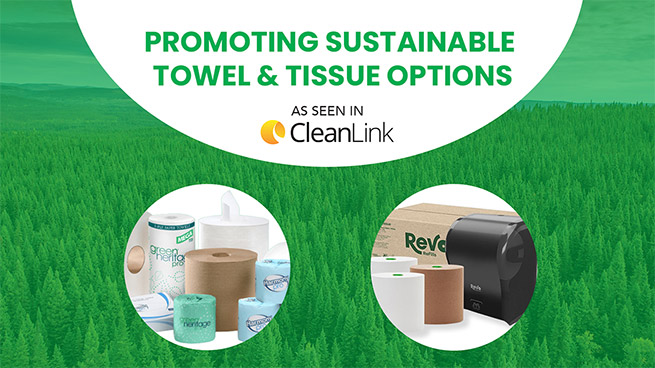In a recent Q&A for Sanitary Maintenance magazine, Laura Ashley, Marketing Manager for Resolute Tissue, along with other manufacturers, discusses sustainable tissue and towel options, and what can be done to assist end users with their own green initiatives.
What sustainable attributes are most important when differentiating between green towel and tissue options?
Ashley: Three key attributes come to mind: fiber source, carbon footprint, and waste stream management. When it comes to fiber source, distributors should recommend options with certified fiber sourcing, recycled fiber (both pre- and post-consumer), certified sources (which can be a combination of certified forest and recycled fiber), and recycled sources both for the product and product packaging (these factors include recyclability, being compostable, and being biodegradable). Regarding waste stream management, this includes all phases of the product life, from production through end use.
What selling points should distributors highlight when promoting sustainable towel/tissue options?
Ashley: Distributors, end users and consumers want assurances that their buying decisions represent a sound environmental choice. They are asking for proof that tissue products are made with raw material originating from sustainably managed forests, recycled material, and/or controlled sources. In the North American market, fiber certification gives that proof point that ensures either the fiber is from:
1) A manufacturer buying fiber from a certified forest,
2) A manufacturer buying fiber from a legally operating forest,
3) A manufacturer buying fiber from a combination of the above (it can also include recycled fiber in the combination); or
4) A manufacturer buying 100 percent recycled fiber.
What other advice do you have for distributors looking to drive the sale of green paper products?
Ashley: Promote product lines that have certified fiber sources, such as SFI Certified Sourcing, FSC, or Green Seal. Look for on-package certified sourcing logos with certification numbers, which prove that the manufacturer is indeed certified and is purchasing from certified forests/sources. A certified sourcing logo confirms a third-party audit from a certified organization.
What are some of the more common materials used to make sustainable paper products? Are there any alternative materials that can be used to further expand the green paper category?
Ashley: Common materials used from most available to least available are virgin fiber from certified forests and sources; a combination of virgin fiber mixed with recycled materials; and 100 percent recycled fiber. In our industry, there is much more capacity to produce virgin fiber-based products versus recycled fiber-based products.
In terms of cost, how do green certified paper products compare to non-certified options, and what tips can you provide distributors struggling with sales?
Ashley: Some certified paper products may be more expensive now. For example, recycled fiber is much less available than in prior years, and therefore can be more expensive than readily available virgin fiber. It is a very common and unfortunate misconception that the only sustainable paper product is a recycled content paper. This is not true. Distributors should purchase from manufacturers offering certified fiber sources, which could be 100 percent virgin fiber, a combination of virgin and recycled fiber, or 100 percent recycled fiber.
There was a perception that recycled doesn’t dry as well as traditional products. How have things changed and how can distributors respond to these statements?
Ashley: If you are referring to brown recycled towels, things have not changed. The water absorption capacity on paper towels depends not only on fiber type (recycled vs. virgin), but also other characteristics: fiber length, caliper, tensile strength, percentage stretch and additives. It is important to educate distributors on these characteristics, as the right formula will produce a high-quality towel. The reason why recycled towels do not dry quite as well as virgin paper towels is due to the length of the fibers. Recycled fiber typically contains shorter fibers, which lead to weaker paper. The longer fibers of virgin fiber produce paper towels with higher tensile strength in both directions, thus making it a stronger substrate when used for absorbing water. A distributor could offer a certified virgin fiber towel and convey assurances to their customer that they are making a sound environmental choice.
Read the full article where it originally appears on CleanLink.

Source: Resolute Tissue













